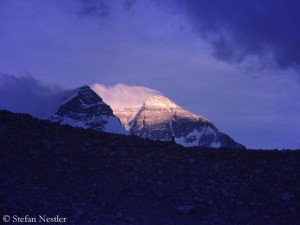Normal, and that’s good
Bad news is good news, learns every prospective journalist. But actually it also can be good news, if there is no bad one. This spring, this applies particularly to Mount Everest, after the disasters of the past two years. In spring 2014, the season on the Nepalese side ended prematurely, after an ice avalanche in the Khumbu Icefall had killed 16 Nepali climbers. 2015 even turned out to be a year without summit success on both sides of the mountain due to the devastating earthquake in Nepal. On the south side, 19 people lost their lives, when the quake triggered an avalanche that hit the Base Camp. Later all climbers departed. On the north side, the Chinese authorities closed all eight-thousanders after the earthquake in the neighboring country. This year, in my view, the Everest season is running so far largely normal.
Rope-fixing team soon on the top?
On the Nepalese side of Everest, Climbing Sherpas have prepared the route up to a point just below the 7,900-meter-high South Col. They had to interrupt their work because of smaller avalanches in the Lhotse flank. Some commercial teams have meanwhile stayed overnight in Camp 3 at about 7,000 meters for further acclimatization. On the Tibetan north side, the rope-fixing team of the China Tibet Mountaineering Association (CTMA) has reached an altitude of about 8,200 meters on the Northeast Ridge. The team “hope to go to the summit on the 5th”, American climber Adrian Ballinger wrote on Instagram yesterday. On the south side, it’s expected by next week that the rope-fixing Sherpas will reach the summit.
Not unusual
Anything else? The Nepalese newspaper “The Himalayan Times” reports that so far 17 foreign and ten Nepalese mountaineers had to be flown out from Base Camp because they showed symptoms of HAPE and HACE. These figures seem to be spectacular at first glance, but are likely to be on average of a normal Everest season. On the south side, there are some complaints about the work of the Climbing Sherpas, but this also happens time and again. Lastly, the media excitement about helicopter tourist flights over the Khumbu Icefall is understandable and justified. But that the topic receives so much attention at all, shows that the real climbing season on Everest has been running so far without major incidents. And that’s good news, right?









